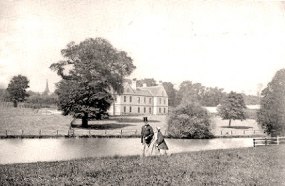Photographs (lost buildings)
Photographs (surviving buildings)
Residents Reminiscence
Questions
Leeds Photographic Archive
Overview
![]()
Seacroft Village is of ancient foundation. It is listed in the Domesday Book and has the oldest remaining village green in England but, in fact, has a much older history. The Venerable Bede records the battle of Winwaed between King Oswy's forces and the, unsuccessful, invading Mercians under King Penda. Bede gives this as taking place near Seacroft on the 15th November 655AD. The name (originally Saecroft) is of Saxon origin - sae meaning pool or lake and croft meaning enclosure or farm.
![]()
After the Norman invasion, Seacroft (as part of the parish of Whitkirk) was granted to Gilbert de Laci and it remained in the de Laci family until 1602, when James 1st granted it to George Shiletto whence it passed into the ownership of his wife and then to her second husband Sir Ralph Hansby. He sold it to James Nelthorpe of Windsor in 1656.
![]()
In 1643 a battle between Royalists for Charles I and a group of Roundheads under Sir Thomas Fairfax, who were en-route from Tadcaster to Leeds, took place at Seacroft. Fairfax was obliged to retreat across Bramham moor.
![]()
St James's Church was built in 1845 and the Wilson family, contemporary owners of Seacroft Hall, were major contributors to the cost.
![]()
 Seacroft Hall itself was thought to have been built by the Shilettos in about 1605. By the 19th century, the Manor of Seacroft was in the hands of the Wilson family. Darcy Bruce Wilson (1851 to 1936) was the the last owner of Seacroft Hall, which became derelict after his death. Though a listed building, it was demolished in 1954 and a High School now occupies its site. All that remains now of the Hall is the Lodge (gatehouse) on York Road, recently used as part of a Council depot but now derelict. The illustration is a photograph of the Hall, taken about 1880, showing the lake which was latterly called the Fish Pond before being drained in the 1950's.
Seacroft Hall itself was thought to have been built by the Shilettos in about 1605. By the 19th century, the Manor of Seacroft was in the hands of the Wilson family. Darcy Bruce Wilson (1851 to 1936) was the the last owner of Seacroft Hall, which became derelict after his death. Though a listed building, it was demolished in 1954 and a High School now occupies its site. All that remains now of the Hall is the Lodge (gatehouse) on York Road, recently used as part of a Council depot but now derelict. The illustration is a photograph of the Hall, taken about 1880, showing the lake which was latterly called the Fish Pond before being drained in the 1950's.
Back to Top
Photographs (lost buildings)
Photographs (surviving buildings and features)
Residents' Reminiscence
Memories of Seacroft as a Village 1926 to 1947 - Alan Noble
Back to Top
Questions You Might Help With
Have a look at this list of questions and see if you can provide any answers.
If you can, use the Talk to Us button and let us know.
You can also tell us if you have any questions of your own about Village history and we can post them on this list and see if anyone can help with information.
Back to Top



















